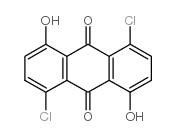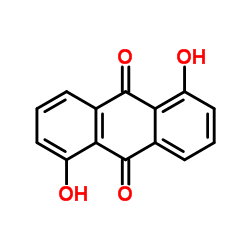6837-97-4
| 英文名 | 1,5-dichloro-4,8-dihydroxyanthracene-9,10-dione |
|---|---|
| 英文别名 |
1,5-Dichlor-4,8-dihydroxy-anthrachinon
4,8-Dichloroanthrarufin EINECS 229-924-4 Dichloroanthrarufin 4,8-dichloro-1,5-dihydroxyanthrachinone 1,5-Dichloro-4,8-dihydroxyanthraquinone Anthrarufin,4,8-dichloro 9,10-Anthracenedione,1,5-dichloro-4,8-dihydroxy |
| 密度 | 1.718g/cm3 |
|---|---|
| 沸点 | 556.3ºC at 760 mmHg |
| 分子式 | C14H6Cl2O4 |
| 分子量 | 309.10100 |
| 闪点 | 290.2ºC |
| 精确质量 | 307.96400 |
| PSA | 74.60000 |
| LogP | 3.18000 |
| 折射率 | 1.735 |
Synonym:Dichloroanthrarufin; 4,8-Dichloro-1,5-Dihydroxyanthraquinone Section 2 - COMPOSITION, INFORMATION ON INGREDIENTS
Risk Phrases: 40 Section 3 - HAZARDS IDENTIFICATION EMERGENCY OVERVIEW
Limited evidence of a carcinogenic effect.The toxicological properties of this material have not been fully investigated. Potential Health Effects Eye: May cause eye irritation. Skin: May cause skin irritation. Ingestion: May cause irritation of the digestive tract. The toxicological properties of this substance have not been fully investigated. Inhalation: May cause respiratory tract irritation. The toxicological properties of this substance have not been fully investigated. Chronic: No information found. Section 4 - FIRST AID MEASURES Eyes: Flush eyes with plenty of water for at least 15 minutes, occasionally lifting the upper and lower eyelids. Get medical aid. Skin: Get medical aid. Flush skin with plenty of water for at least 15 minutes while removing contaminated clothing and shoes. Wash clothing before reuse. Ingestion: Get medical aid. Do NOT induce vomiting. If conscious and alert, rinse mouth and drink 2-4 cupfuls of milk or water. Inhalation: Remove from exposure and move to fresh air immediately. If not breathing, give artificial respiration. If breathing is difficult, give oxygen. Get medical aid. Notes to Physician: Section 5 - FIRE FIGHTING MEASURES General Information: As in any fire, wear a self-contained breathing apparatus in pressure-demand, MSHA/NIOSH (approved or equivalent), and full protective gear. During a fire, irritating and highly toxic gases may be generated by thermal decomposition or combustion. Extinguishing Media: Use agent most appropriate to extinguish fire. Use water spray, dry chemical, carbon dioxide, or appropriate foam. Section 6 - ACCIDENTAL RELEASE MEASURES General Information: Use proper personal protective equipment as indicated in Section 8. Spills/Leaks: Clean up spills immediately, observing precautions in the Protective Equipment section. Sweep up or absorb material, then place into a suitable clean, dry, closed container for disposal. Provide ventilation. Section 7 - HANDLING and STORAGE Handling: Wash thoroughly after handling. Remove contaminated clothing and wash before reuse. Use with adequate ventilation. Avoid contact with eyes, skin, and clothing. Keep container tightly closed. Avoid ingestion and inhalation. Storage: Store in a tightly closed container. Store in a cool, dry, well-ventilated area away from incompatible substances. Section 8 - EXPOSURE CONTROLS, PERSONAL PROTECTION Engineering Controls: Facilities storing or utilizing this material should be equipped with an eyewash facility and a safety shower. Use adequate ventilation to keep airborne concentrations low. Exposure Limits CAS# 6837-97-4: Personal Protective Equipment Eyes: Wear appropriate protective eyeglasses or chemical safety goggles as described by OSHA's eye and face protection regulations in 29 CFR 1910.133 or European Standard EN166. Skin: Wear appropriate protective gloves to prevent skin exposure. Clothing: Wear appropriate protective clothing to prevent skin exposure. Respirators: A respiratory protection program that meets OSHA's 29 CFR 1910.134 and ANSI Z88.2 requirements or European Standard EN 149 must be followed whenever workplace conditions warrant respirator use. Section 9 - PHYSICAL AND CHEMICAL PROPERTIES Physical State: Not available. Color: Not available. Odor: Not available. pH: Not available. Vapor Pressure: Not available. Viscosity: Not available. Boiling Point: Not available. Freezing/Melting Point: 0 deg C Autoignition Temperature: Not applicable. Flash Point: Not applicable. Explosion Limits, lower: Not available. Explosion Limits, upper: Not available. Decomposition Temperature: Solubility in water: Specific Gravity/Density: Molecular Formula: C14H6Cl2O4 Molecular Weight: 309.09 Section 10 - STABILITY AND REACTIVITY Chemical Stability: Stable under normal temperatures and pressures. Conditions to Avoid: Incompatible materials, strong oxidants. Incompatibilities with Other Materials: Oxidizing agents. Hazardous Decomposition Products: Carbon monoxide, irritating and toxic fumes and gases, carbon dioxide, oxides of chlorine. Hazardous Polymerization: Has not been reported Section 11 - TOXICOLOGICAL INFORMATION RTECS#: CAS# 6837-97-4: CB6498500 LD50/LC50: Not available. Carcinogenicity: 9,10-Anthracenedione,1,5-Dichloro-4,8-Dihydroxy- - Not listed by ACGIH, IARC, or NTP. Other: See actual entry in RTECS for complete information. Section 12 - ECOLOGICAL INFORMATION Section 13 - DISPOSAL CONSIDERATIONS Dispose of in a manner consistent with federal, state, and local regulations. Section 14 - TRANSPORT INFORMATION IATA Not regulated as a hazardous material. IMO Not regulated as a hazardous material. RID/ADR Not regulated as a hazardous material. Section 15 - REGULATORY INFORMATION European/International Regulations European Labeling in Accordance with EC Directives Hazard Symbols: XN Risk Phrases: R 40 Limited evidence of a carcinogenic effect. Safety Phrases: S 28A After contact with skin, wash immediately with plenty of water. S 36/37 Wear suitable protective clothing and gloves. S 37 Wear suitable gloves. S 45 In case of accident or if you feel unwell, seek medical advice immediately (show the label where possible). WGK (Water Danger/Protection) CAS# 6837-97-4: No information available. Canada CAS# 6837-97-4 is listed on Canada's NDSL List. CAS# 6837-97-4 is not listed on Canada's Ingredient Disclosure List. US FEDERAL TSCA CAS# 6837-97-4 is listed on the TSCA inventory. SECTION 16 - ADDITIONAL INFORMATION N/A |
CHEMICAL IDENTIFICATION
HEALTH HAZARD DATAACUTE TOXICITY DATAMUTATION DATA
|
| 海关编码 | 2914700090 |
|---|
|
~50% 
6837-97-4 |
| 文献:Universitaet Heidelberg Patent: EP1905801 A1, 2008 ; Location in patent: Page/Page column 7,8 ; |
| 上游产品 1 | |
|---|---|
| 下游产品 2 | |
| 海关编码 | 2914700090 |
|---|---|
| 中文概述 | 2914700090 其他酮及醌的卤化、磺化衍生物(包括硝化和亚硝化衍生物). 增值税率:17.0% 退税率:9.0% 监管条件:无 最惠国关税:5.5% 普通关税:30.0% |
| 申报要素 | 品名, 成分含量, 用途, 丙酮报明包装 |
| Summary | HS: 2914700090 halogenated, sulphonated, nitrated or nitrosated derivatives of ketones and quinones, whether or not with other oxygen function Tax rebate rate:9.0% Supervision conditions:none VAT:17.0% MFN tariff:5.5% General tariff:30.0% |


![2,2'-[[(9,10-Dihydro-4,8-dihydroxy-9,10-dioxoanthracene)-1,5-diyl]bisimino]bis(5-methylbenzenesulfonic acid)结构式](https://image.chemsrc.com/caspic/173/10449-13-5.png)
![9,10-Anthracenedione,1,5-dihydroxy-4,8-bis[(4-methylphenyl)amino]结构式](https://image.chemsrc.com/caspic/251/20241-75-2.png)